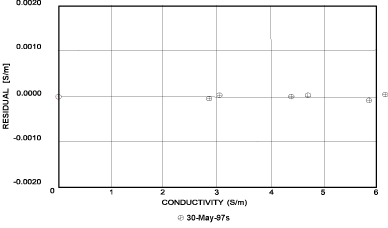 Conductivity Sensor
Conductivity SensorSBE 4
 Conductivity Sensor
Conductivity Sensor![]()
![]() Print version
Configuration options & accessories -
4C or
4M
Print version
Configuration options & accessories -
4C or
4M
|
|
DESCRIPTION
SBE 4 series conductivity sensors are modular, self-contained instruments that measure conductivity from 0 to 7 S/m (Siemens/meter), thus covering the full range of lake and oceanic applications. The sensors (Version 2; S/N 2000 and higher) have electrically isolated power circuits and optically coupled outputs to eliminate any possibility of noise and corrosion caused by ground loops. Interfacing is also simplified by the square-wave variable frequency output signal (nominally 2.5 to 7.5 kHz, corresponding to 0 to 7 S/m). The sensors offer improved temperature compensation, smaller fit residuals, and faster turn-on stabilization times. Supply voltage range is 6 to 24 volts.
The SBE 4C is a primary sensor for the SBE 9plus CTD Underwater Unit and SBE 25 and 25plus Sealogger CTD. Available in 6800 meter (22,300 ft) aluminum or 10500 meter (34,400 ft) titanium housing, the SBE 4C has a quick-disconnect fitting to simplify plumbing to the CTD pump. The SBE 4M is intended for long-term moored deployments. Available with a 3400 meter (11,100 ft) or 6800 meter (22,300 ft) aluminum housing or 10500 meter (34,400 ft) titanium housing, the SBE 4M is supplied without the quick-disconnect fitting.
The sensing element is a cylindrical, flow-through, borosilicate glass cell with three internal platinum electrodes. The electrode arrangement offers distinct advantages over inductive or open external field cells. Because the outer electrodes are connected together, electric fields are confined inside the cell, making the measured resistance (and instrument calibration) independent of calibration bath size or proximity to protective cages or other objects. The cell resistance controls the output frequency of a Wien Bridge oscillator circuit. A unique Sea-Bird design feature introduces a fixed conductivity offset, permitting the instrument to measure conductivity down to 0 for fresh water work.
APPLICATION
Because of the SBE 4's low noise characteristics, hybrid frequency measuring techniques (used in Sea-Bird's CTD instruments) may be used to obtain rapid sampling with very high temporal and spatial resolution. The SBE 4 is ideally suited for obtaining horizontal data with towed systems or vertical data with lowered systems. Because of its small size, it is especially useful for moorings, portable CTD systems, or through-the-ice work.
 SPECIFICATIONS 1
SPECIFICATIONS 1
Measurement Range: 0.0 - 7.0 Siemens/meter (S/m)
Initial Accuracy: ± 0.0003 S/m
Stability 2: 0.0003 S/m/month
Resolution 3: 0.00004 at 24 Hz
Time Response 4: 0.060 seconds (pumped)
Settling Time: 0.7 seconds to within 0.0001 S/m
Supply Voltage: 6 - 24 VDC
Supply Current: 18 mA at 6V; 12 mA at 10 - 24 V
Signal Output: 1 V square wave capacitively coupled
¹ Typical specifications, referenced
to NIST-traceable calibration.
² Not applicable in areas of high
biofouling activity or highly contaminated waters, or if procedures
in Application
Note 2D are not
followed.
³ Achieved with SBE 9 CTD.
In custom applications, resolution will depend on the frequency
measuring technique used.
4
Time to reach 63% of final value following a step change in
conductivity.
| Housing | Depth Rating | Weight |
| 6061 aluminum-T6 | 3400 meters | 0.7 kg (1.6 lbs) in air; 0.34 kg (0.75 lbs) in water |
| 7075 aluminum-T6 | 6800 meters | 0.7 kg (1.6 lbs) in air; 0.34 kg (0.75 lbs) in water |
| 6Al-4V titanium | 10500 meters | 1.1 kg (2.4 lbs) in air; 0.7 kg (1.5 lbs) in water |
CALIBRATION
Sea-Bird calibrates the sensors over the range of 2.6 to 6 S/m in a computer-controlled bath, using natural seawater; a water sample at each point is compared to IAPSO seawater using a Guildline Autosal. A least-squares fitting technique (also including a zero conductivity point in air) yields calibration coefficients for use in the following equation:
Conductivity [S/m] = ( g + hf 2 + if 3 + jf 4 ) / 10 (1 + dt + ep)
where f is instrument frequency [kHz], t is temperature [°C], p is pressure [decibars], and d is thermal coefficient of expansion (3.25 x 10 -06) and e is bulk compressibility (-9.57 x 10 -08) of the borosilicate cell. The resulting coefficients g, h, i, and j are listed on the calibration certificate. Residuals are typically less than 0.0002 S/m.
Sample Calibration Data
Calibration data for sensor serial number = 2020
Calibration date: 30 May 97
Practical Salinity Scale 1978: C(35,15,0) = 4.2914 [Siemens/meter]g = -1.05697877e+01 h = 1.42707291e+00 i = -4.32023820e-03 j = 4.53455585e-04
| Bath
Temperature (°C68) |
Bath
Salinity (ppt) |
Bath
Conductivity (S/m) |
Instrument
Frequency (kHz) |
Instrument
Conductivity (S/m) |
Residual
[Instrument - Bath] (S/m) |
| 0.0000 | 0.0000 | 0.0000 | 2.72957 | 0.0000 | 0.0000 |
| 1.3428 | 35.2722 | 2.80855 | 5.22318 | 2.80850 | -0.00005 |
| 1.0942 | 35.2724 | 3.01943 | 5.36370 | 3.01947 | 0.00004 |
| 15.2226 | 35.2731 | 4.34337 | 6.17207 | 4.34338 | 0.00001 |
| 18.6914 | 35.2731 | 4.69132 | 6.36724 | 4.69135 | 0.00003 |
| 29.0800 | 35.2708 | 5.77613 | 6.93974 | 5.77603 | -0.00010 |
| 32.6309 | 35.2657 | 6.15878 | 7.13053 | 6.15885 | 0.00007 |

ADDITIONAL INFORMATION / LINKS:
Documentation -- manual, photos, technical papers, application notes, etc.
Sales Information -- options, accessories, spares, mount kits, cables, etc.
Links to Other Instruments of Interest
![]()
Specifications are subject to change without notice.
Sea-Bird Home Phone: (+1) 425-643-9866 E-mail: seabird@seabird.com